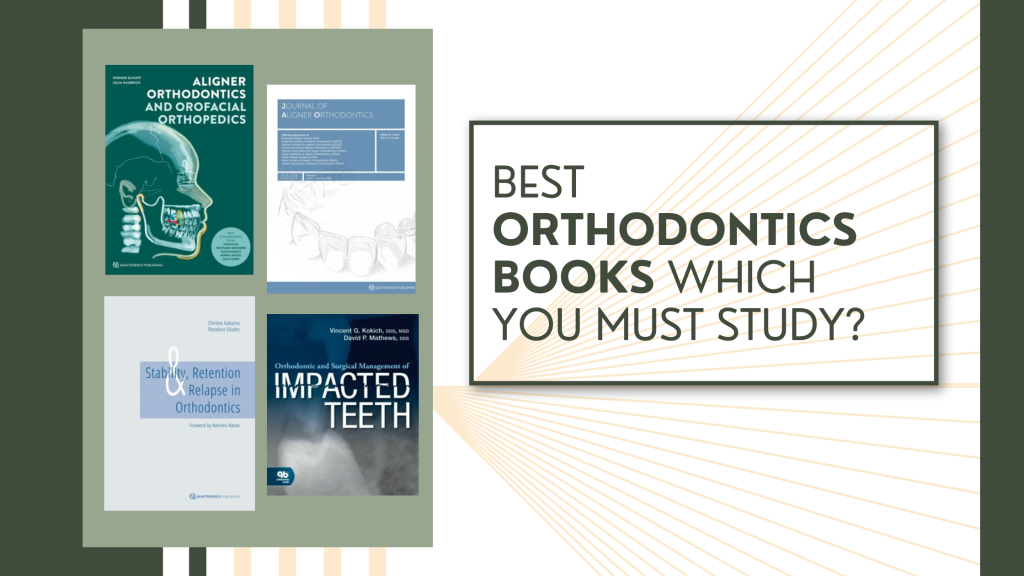Orthodontics is a sub-part of dentistry. This sub-domain of dentistry is quite popular as most people suffer from orthodontic problems which not only affect the appearance of teeth and their function but can cause further anatomical problems. This is why orthodontic treatment is essential.

Practitioner practicing orthodontics must keep on upgrading their knowledge of this dynamic field of orthodontics. This means orthodontics must keep on upgrading their knowledge to ensure they are providing their patients with the best care. Studying new books that discuss the latest developments in orthodontics:
Aligner Orthodontics and Orofacial Orthopedics by Werner Schupp and Julia Haubrich:
This orthodontics book provides helpful guidance and techniques for successfully implementing aligner orthodontics into clinical practice, whether it is done in-office or through outsourcing. The authors discuss the biomechanics of the aligner and the diagnostic processes before offering the aligner orthodontics techniques in this second edition. Each malocclusion is described using case material and supported by information on the associated symptoms, the rationale for the selected treatment approaches, and the range of outcomes achieved. With the help of the sections devoted to each malocclusion, patients and doctors may determine if this technique will yield the best potential treatment outcomes for a particular clinical situation. Any medical professional thinking about treating patients with aligner orthodontics will benefit from this helpful advice.
Journal of Aligner Orthodontics – ISSN (online) 2514-7560
In the discipline of aligner orthodontics, the Journal of Aligner Orthodontics publishes clinically relevant papers. The peer-reviewed article presents the whole breadth of the field and claims to be the standard for aligner orthodontics. The publication aims to provide thorough information to orthodontists and everybody else interested in orthodontics, regardless of expertise level. Articles contain basic procedures, scenario-specific case reports, multidisciplinary therapy, which includes aligner techniques, and original research, which includes clinical investigations, material and device studies, and literature reviews. Auxiliary operations such as 3D printing and scanning are also mentioned. In addition, the magazine features business news, book reviews, expert discussions, summaries of articles from other journals, editorials, guidance, and lessons learned.
Stability, Retention and Relapse in Orthodontics by Christos Katsaros and Theodore Eliades (Editor)
This orthodontics book explains the critical components of a successful intervention and offers a thorough analysis of the Stability and Retention of orthodontic treatment outcomes. Incidence irregularity, Class I, Class II, transverse, vertical challenges, stability inclinations, and relapse of orthodontic therapy are discussed together with the outcomes of orthognathic surgery. The authors warn against tooth and jaw movements that have been linked to an increased risk of relapse and discuss the use of fixed and removable retention appliances. They also outline treatment principles to minimise relapse and the development of potential unwanted effects at the retention stage. The final result is an understanding of how to design personalised retention plans for individual patients and how to apply strategic insight in long-term treatment planning.
Orthodontic and Surgical Management of Impacted Teeth by Vincent G. Kokich and David P. Mathews
In dental practice, impacted teeth are frequently encountered, but as of yet, no comprehensive book describes the surgical procedures and orthodontic therapy needed to extract or repair these teeth. This text covers the various types of impactions that an orthodontist and surgeon will encounter, including maxillary central incisors, maxillary canines (both liberally and palatably impacted), mandibular canines, premolars, and mandibular molars. This book was written by arguably the best orthodontist in the world as well as his periodontist colleague of nearly 40 years. Every chapter concentrates on a single impacted tooth and describes the surgical and orthodontic methods for exposing and moving it. The book also includes a chapter on unsuccessful cases, outlining what went wrong and offering advice on how to handle situations that are similar in the future to avoid similar outcomes.
These are some of the top books that you should be reading if you are a dental practitioner who is practicing orthodontics. It will help you expand your knowledge and offer improved treatment to your patients. This will help you to also improve your technique and skill set.
